Faye Fite's Blog, page 27
March 4, 2016
7 Tips For Choosing Your Character's Appearance
Let’s talk about character appearance.
This is an aspect of descriptive writing that I never really considered up until a few weeks ago. In a film class I'm taking this semester, we just finished learning about character makeup, costume, hairstyle, and how all of these elements are carefully designed to add to our perception of the character. I was blown away by the amount of care that goes into these decisions, and even more blown away by the fact that they make complete sense.
All I could think was, “Why are we not utilizing this technique as writers?”
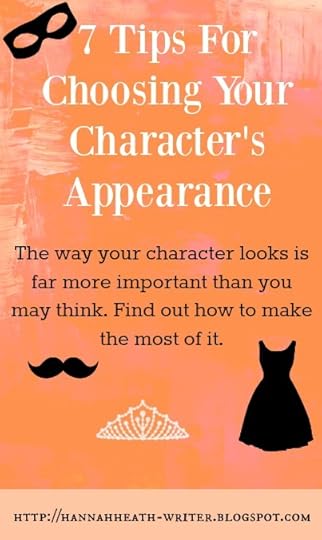 Character appearance should go far beyond just allowing your reader to have a idea of what your character looks like. The way your character looks and dresses can, in fact, deepen the character’s personality, make them more realistic, and work to accent their role in the story.
Character appearance should go far beyond just allowing your reader to have a idea of what your character looks like. The way your character looks and dresses can, in fact, deepen the character’s personality, make them more realistic, and work to accent their role in the story. And you know what’s great about character appearance? It has a lot of impact but is fairly easy to implement. Here are 7 tips to keep in mind when shaping and describing your character’s appearance:
1. Physical appearance shouldn’t be left to chance. I’ve read a lot of books where authors take care to throw in hints about the character’s hair and eye color. They let us know that the person has a slight build, full lips, or dark skin. And then, ten pages later, I completely forget what the character looks like. Why? Because it makes no difference to the story. So the character has blue eyes. That matters because….? Don’t just slap together a character based on the fact that you like red hair and always wanted to have green eyes. This is a creation that you are hoping to make come across as a real person. His or her appearance deserves some thought.
2. Physical appearance can be used to help with world building. If you write fantasy, sci-fi, or any other writing that requires the creation of an entirely new world, remember that there should probably be different races of people in your story. You can use character appearance to help highlight each race. For example, Tolkien’s elves tend to be tall, light-skinned, and fair haired, so it makes sense that they tend to live in the woods. Hobbits are short and don't draw much attention to themselves, which is fine because they're quiet folks and want to be left alone. Even if you are writing books set in our world, physical appearance can still help you build a realistic setting. If you’re writing in a Victorian setting, does your female character have dark skin? Then she’s going to stand out, because, at that time, it was desirable to have a fair complexion. Or maybe you have a tall high school boy who would rather study physics than play basketball. Whatever the scenario, physical appearance can and should be used to help you deepen your fictional world rather than just being thrown in at random.
3. Use physical traits to accentuate or contrast personality. And no I’m not talking about, “She has red hair and a bad temper.” Can we stop with that one already? Please? I just read a book ( Scout's Progress , to be exact) in which one of the characters is described as ‘fox-faced.’ This fits his personality, as he is very clever, observant, and a bit of a rogue. However, his appearance frightens some people, an interesting dilemma, since he is a very loyal, kind man. I thought this was fairly genius, because not only will I always remember what this character looks like, but his appearance will help me remember his personality, thus working to make him an unforgettable character. You can also try making a certain look inextricably entwined with a certain behavior: A girl who juts her unusually sharp chin out, making herself look harsh and intimidating in an attempt to be taken seriously. This one is also a perfect example:
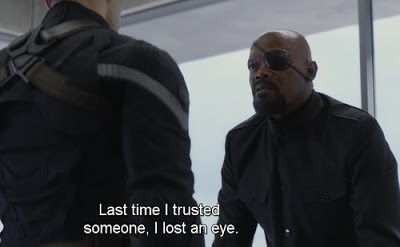 4. Remember that clothing says a lot about a person. Just think about it for a minute. When you first meet a person, you probably notice their face first, then their clothing, then mix that information with what you know about said person to come up with an idea of what this person is like. The same exact principle applies to fictional people. Lets do a break down of two characters to help you see what I'm talking about: The Joker
4. Remember that clothing says a lot about a person. Just think about it for a minute. When you first meet a person, you probably notice their face first, then their clothing, then mix that information with what you know about said person to come up with an idea of what this person is like. The same exact principle applies to fictional people. Lets do a break down of two characters to help you see what I'm talking about: The Joker
 He wears oddly colorful clothes and both his hair and his socks match his outfit, showing his attention to detail. Despite what he says, he is clearly a man with a plan. His painted-on smile is fairly comical, but the dark shading around his eyes is frightening. One look at him and you know: this guy is psychotic, dangerous, but also knows what he's doing.Astrid Hofferson
He wears oddly colorful clothes and both his hair and his socks match his outfit, showing his attention to detail. Despite what he says, he is clearly a man with a plan. His painted-on smile is fairly comical, but the dark shading around his eyes is frightening. One look at him and you know: this guy is psychotic, dangerous, but also knows what he's doing.Astrid Hofferson
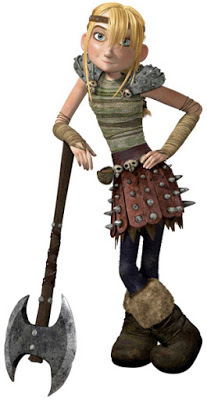 She wears a skirt, so she's not ashamed of her femininity. She has an open, round face and large eyes, giving her a pleasant look. But she also wields a hefty ax and sports skulls and spikes. Clearly, she's a girl with an edge who knows how to take care of herself, but isn't as mean as she may want people to think.
She wears a skirt, so she's not ashamed of her femininity. She has an open, round face and large eyes, giving her a pleasant look. But she also wields a hefty ax and sports skulls and spikes. Clearly, she's a girl with an edge who knows how to take care of herself, but isn't as mean as she may want people to think. 5. Try flipping stereotypes completely around. The super shy girl who loves to wear bright red lipstick. The hippie-looking dude with long hair who is actually very conservative and loves math (that's actually a description of my brother, but he's the perfect example of an inverted stereotype). Your bad guy is allowed to wear white and a mask doesn't always have to hide a scary countenance (think Scarecrow and Kylo Ren). Whatever it is, it's always fun to break out of the stereotypes and use it to create a unique character that really stands out.
6. Try breaking character appearance. This should only be used in acute situations to show the intensity of a character's emotion. The guy who always carries two guns is only wearing one, perhaps because he received horrible news and left his house in a hurry. The girl who's always put together looks like a complete mess. A prime example of breaking character appearance would be Loki:
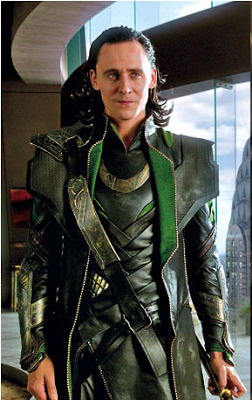 Above is how he usually looks: perfectly groomed and wearing nice clothes, showing his royal descent. His slightly mischievous smile and slicked back hair making him look completely in control and every bit the trickster. That's why everyone's heart broke when we saw him like this:
Above is how he usually looks: perfectly groomed and wearing nice clothes, showing his royal descent. His slightly mischievous smile and slicked back hair making him look completely in control and every bit the trickster. That's why everyone's heart broke when we saw him like this:
 Here Loki is completely lost. His hair is out of place, he's not wearing any signs of his royalty, he's bleeding, and for perhaps the first time in any of the movies, he's letting his true emotions show clearly on his face. This Loki is at complete odds with the usual Loki: he's no longer in control and has fallen a long, long way. This sharp contrast is heartrending and goes to show us just how much Loki loved his mother.
Here Loki is completely lost. His hair is out of place, he's not wearing any signs of his royalty, he's bleeding, and for perhaps the first time in any of the movies, he's letting his true emotions show clearly on his face. This Loki is at complete odds with the usual Loki: he's no longer in control and has fallen a long, long way. This sharp contrast is heartrending and goes to show us just how much Loki loved his mother. 7. Avoid laundry list descriptions. This is a writing technique that was birthed in hell and raised in the fiery inferno of laziness and lack of imagination. It's when a writer decides to say: "She had red hair that fell past her waist, green eyes, and a freckled nose. She wore a long white dress with blue leggings and tiny black shoes. She wore white ribbons in her hair and a golden necklace...." Please don't do this. You do not have to describe your character all at once. It's okay to add little details as the story goes on. And, as mentioned above, characters appearance is best described as part of the story, not just random, extraneous details.
Do you like to put a lot of meaning behind your character's appearance, or do you think that's overrated? How do you describe the people in your stories? I'd love to hear about your methods!
Related articles:
7 Cliche Characters in YA Fiction That Need to Stop
Writing Surfer Characters: 9 Things You Need to Know
Challenging Creative Writers To Be More Creative
Enjoy this post? Take a look around. If you like what you see, please don't forget to subscribe by email for a new post every week!

Published on March 04, 2016 07:41
February 26, 2016
Polymer Clay Book Tutorial + A Review of A Monster Calls by Patrick Ness
Have you ever read a book that you just can’t stop thinking about? You may have finished the story a few hours ago, a few days ago, even a few months ago, but you keep finding yourself drawn back to it.
It happens to me. Not very often, but sometimes. See, I have this weird idea that stories shape me as a person. The bad books remind me of how I don’t want to be. The good books show me what I should strive for. And the great books? The great books show me myself: both as I am and as I can be.
 That being said, Great Books are nearly impossible to find. When I am fortunate enough to stumble across one, I hold on to it like Gollum holds onto his precious.
That being said, Great Books are nearly impossible to find. When I am fortunate enough to stumble across one, I hold on to it like Gollum holds onto his precious. The most recent Great Book I’ve found is A Monster Calls. It was created by two brilliant writers: Patrick Ness, who wrote the book, and Siobhan Dowd, who had the idea for the story, but died of breast cancer before she had time to write it out.
Only great matters, matters of life and death, can make the monster come walking. And the monster has come for Conor O'Malley. He wants Conor to tell a story. But how can stories be important when other, far more important things are happening? How can stories matter when his mother's treatments aren't working? But stories are wild things, and they hold healing and power that Conor never imagined.
And so it comes about that the monster has come to tell Conor three stories: A tale of saving an evil queen, a story about a selfish healer, and the account of a man that nobody sees. And when the stories are finished, the monster wants a story in return, but not just any story. He wants Conor's story. THE story. He wants to know about the nightmare. He wants Conor to tell the truth.
If you’ve never read anything by Patrick Ness, then I need to explain something to you: His writing style is like nothing I have ever seen in a modern writer. He, unlike so many authors, knows how to write thoughtfully and honestly. He can spin a story that will rip your heart from your chest. But then, rather than grinding it into the dirt, he fills it with hope and truth and puts it back. And it hurts. How could it not? But you walk away from his stories with an ache in your heart and a lopsided smile on your face because you just found a book that actually meant something.
This is especially true for A Monster Calls. Here we have a story about a little boy whose mother is dying. That’s nothing special. It’s a story-line that’s been done a hundred times. But never like this.
A Monster Callsdoesn’t try to make things look different than they really are. It doesn’t show a mother with cancer and try to say that it’s all going to be okay because she has hope and fight. It doesn’t ignore the fact that sickness changes a family, or that sometimes people unwittingly distance themselves from others who are in pain. And it doesn’t give easy, rainbows-and-butterflies answers to these problems. But it also doesn’t make the world look darker than it really is.
As somebody with Lyme, it's nice to read a book that handles the issues of anger, grief, and pain in an honest way. When the monster comes walking for Conor, it doesn't try to explain away any of Conor's rage or loneliness or any of the ugly things that come along with illness and suffering. Instead, it tries to help him find a way to deal with them. And, as the monster helps Conor through his mother's sickness, it also helped me with mine. Maybe this book was my monster come walking.
This is usually when I give you a recipe inspired by this book. But I’m not going to do that this month. A Monster Calls is an important story to me, so I wanted to be able to carry around a reminder of it wherever I go.
Also, there was no food in this book. Sorry. Just killed the mood, didn't I?
Anyway, I decided to make a mini version of the book out of clay. Here, take a look:
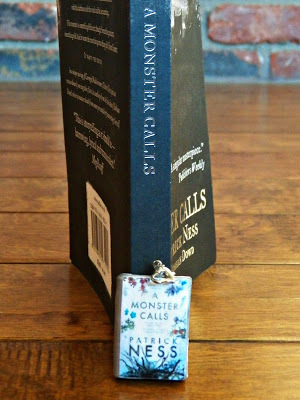
Want to know how I made it? It’s easy:
What you'll need: A knife. Giving a maniacal laugh while holding it is optional. A brush.Mini book cover. You simply go onto Google, find the cover you want, copy to Word, and pare down to whatever size you want it. I like mine to be 1.5 inches tall by 1 inch wide. I also like to print out a back cover with a favorite book quote. Gloss mod podge. I use this kind because it is water-resistant, which is nice if you want to use your book as a key chain. Polymer clay. I use Sculpey, but I wouldn't think that it matters very much. You will need white clay (for the pages), and any other color that will match your paper book cover. An eyepin and a lobster clasp. 1. Gather supplies:
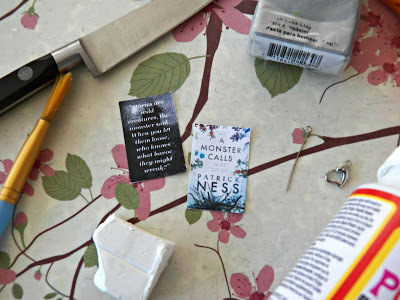 You'll probably want to do this on a place mat, unless you're okay with getting glue and clay on your work-space. I won't judge. 2. Roll out your white clay. Get it as thin or thick as you want, keeping in mind that this will be the pages of your book. Place your book cover on top of the clay.
You'll probably want to do this on a place mat, unless you're okay with getting glue and clay on your work-space. I won't judge. 2. Roll out your white clay. Get it as thin or thick as you want, keeping in mind that this will be the pages of your book. Place your book cover on top of the clay.
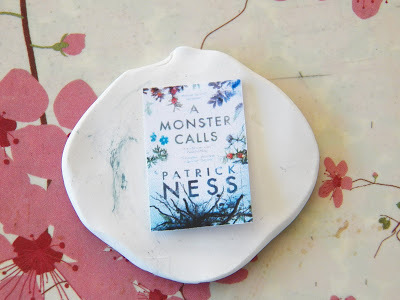 Use your knife to cut the clay out into the same size as the book cover.
Use your knife to cut the clay out into the same size as the book cover.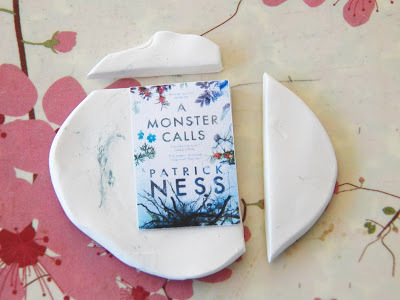 3. Select your clay color for the book covers and spine. Roll out and lay your book cover and book back on top. I chose silver as my color because I thought it would look pretty. When I rolled it out, the clay split partly and I ended up with this:
3. Select your clay color for the book covers and spine. Roll out and lay your book cover and book back on top. I chose silver as my color because I thought it would look pretty. When I rolled it out, the clay split partly and I ended up with this:
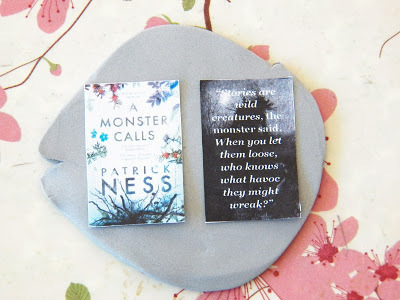 Do you see it? It's the Millennium Falcon. Or a stingray without a tail. But I'm going with the Millennium Falcon. 4. Cut a rectangle around the two book covers, making sure to leave extra space for the spine. Take this rectangle and carefully wrap around your white clay:
Do you see it? It's the Millennium Falcon. Or a stingray without a tail. But I'm going with the Millennium Falcon. 4. Cut a rectangle around the two book covers, making sure to leave extra space for the spine. Take this rectangle and carefully wrap around your white clay:
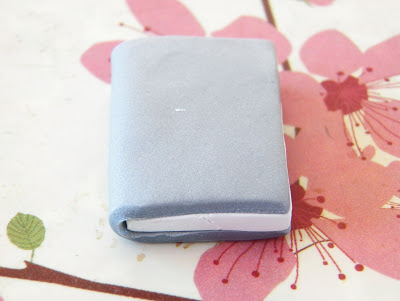 5. Now use your knife to cut small lines along the white clay. This will make them look like book pages:
5. Now use your knife to cut small lines along the white clay. This will make them look like book pages:
 6. Push your eyepin into the top of the book. Pull it out, coat with mod podge, then push back into the hole:
6. Push your eyepin into the top of the book. Pull it out, coat with mod podge, then push back into the hole:
 Wipe excess glue off the top of the book. 7. Bake book in oven per instructions on your clay packet. Unless you want your book to have an ancient papyrus look, you'll want to keep an eye on it, otherwise it might burn.8. Once the book is done baking and has hardened and cooled completely, take it back to your workstation. Paint glue onto the back of your book covers, then stick them to the clay book. I used Elmer's glue before I remembered that mod podge would have worked just fine. It's the Lyme, I swear.
Wipe excess glue off the top of the book. 7. Bake book in oven per instructions on your clay packet. Unless you want your book to have an ancient papyrus look, you'll want to keep an eye on it, otherwise it might burn.8. Once the book is done baking and has hardened and cooled completely, take it back to your workstation. Paint glue onto the back of your book covers, then stick them to the clay book. I used Elmer's glue before I remembered that mod podge would have worked just fine. It's the Lyme, I swear.
 9. Once the glue has dried, paint mod podge onto the front, bottom, top, and sides of the book. Do this in even strokes and try to keep the layer fairly thin. Once dried, flip the book over and seal the back with mod podge, too.
9. Once the glue has dried, paint mod podge onto the front, bottom, top, and sides of the book. Do this in even strokes and try to keep the layer fairly thin. Once dried, flip the book over and seal the back with mod podge, too.
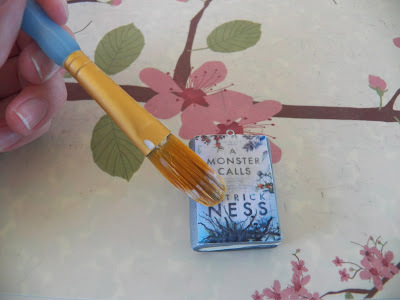 And there you have it! Your very own mini book. They're adorable, like all mini things (except for newborn kangaroos. Those things are creepy). You can use them as key chains, zipper pulls, attach them to your purse, or just set them on your book case.
And there you have it! Your very own mini book. They're adorable, like all mini things (except for newborn kangaroos. Those things are creepy). You can use them as key chains, zipper pulls, attach them to your purse, or just set them on your book case.
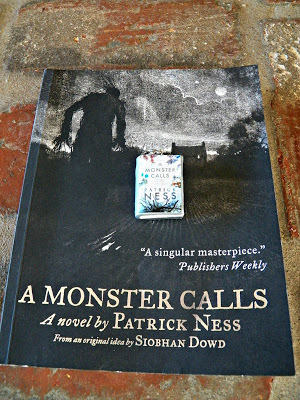 In case you're wondering why the covers don't match, I can explain: I made the mini book using the cover for the non-illustrated book. I ordered the book online and requested the non-illustrated version. However, I ended up getting the illustrated version, so now they don't match. It's throwing off my groove. Thankfully, the back cover matches:
In case you're wondering why the covers don't match, I can explain: I made the mini book using the cover for the non-illustrated book. I ordered the book online and requested the non-illustrated version. However, I ended up getting the illustrated version, so now they don't match. It's throwing off my groove. Thankfully, the back cover matches:
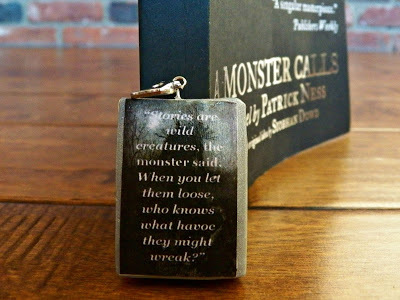 This is one of my favorite quotes from the book. You never know quite where a story will take you, just like you never know for certain where your life will take you. It often runs off in directions that you don't expect it to, and sometimes it goes off in directions that you don't want it to. What are you supposed to do then?
This is one of my favorite quotes from the book. You never know quite where a story will take you, just like you never know for certain where your life will take you. It often runs off in directions that you don't expect it to, and sometimes it goes off in directions that you don't want it to. What are you supposed to do then? Well, as Conor's mother explains: You be as angry as you need to be, she said. Don't let anyone tell you otherwise....And if you need to break things, then by God, you break them good and hard.
But when you're done breaking things, you need to get back up. Instead of trying to ignore things or lie to yourself and say that there is no monster, that there is nothing wrong, you need to tell yourself the truth. Tell yourself your story, your true story, and face your monster. And then take Ness's advice:
Go. Run with it. Make trouble.
If you haven't yet read A Monster Calls, I would strongly recommend that you give it a try. When was the last time you read a book that took hold of your heart and helped you as a person? I'd love to hear of it!
Related articles: Hannah's Novel Notions: A Review of The Knife of Never Letting Go by Patrick NessMy Lloyd Alexander Inspired OutfitLessons From Unbroken by Laura Hillenbrand: The Importance of Never Giving Up
Enjoy this post? Take a look around. If you like what you see, please don't forget to subscribe by email for a new post every week!
Some links are Amazon affiliate links. Thank you for supporting a poor writer!

Published on February 26, 2016 07:50
February 19, 2016
10 Ways to Make the Most Out of a Character Death
I’m always vaguely surprised when I read to the end of a book without having a character die. In this day and age, it seems a matter of course for characters to be dropping right and left like so many mayflies.
Mayflies only live for 24 hours, in case you wanted to know. Which you probably didn’t, but now you do. Read this blog at your own peril.
Anyway, the point is this: Characters die all of the time. Often it’s necessary because a book has become overcrowded. Sometimes it’s done because a character needs extra motivation, or maybe because the readers need to be more engaged emotional. And sometimes it’s just because writers are mean.
Whatever the reason, it’s important to make sure you’re getting your character deaths right. If you’re going to kill off a reader’s favorite character, you better do it in a way that honors said character (NOT like what happened to Fili in The Battle of Five Armies).
Here are some different ways to make the most of killing off a character (or characters, if that’s your style). But first, get in the mood:
Loom over your manuscript, stare at your intended victim and say in a scary, gravelly voice: I am fire. I. AM. DEATH.
Okay. Now you can begin: 1. Give the character a personality. If you create a character specifically to kill him/her off, your construction of him needs to be careful. It’s best to find a way to make him likeable to both the reader and the surrounding characters so as to evoke a lot of emotion when he dies. However, while this is a pretty good strategy, remember to give the character a distinct job in the book other than “pig for slaughter.” If you have this awesome character tagging along for no apparent reason, people are going to know that his days are numbered and thus not be as engaged when he perishes. 2. Give the character a bleak, unfulfilled life. These kinds of characters make some of the best deaths. Give your character something that he has always striven for but never quite made...and will never be able to make. This character is living a half-life, searching for something he/she will never have. They’re not suicidal, but it’s generally understood that death is their way out. Snape lived his entire life without Lily, disliked, mistrusted, and misused by many people. He was proud to serve her after her death, but we all knew that he wasn’t particularly happy with his lot. This made his death heartrending because we didn’t want him to die but also knew that it probably needed to take place. The same goes for Maximus in Gladiator (he lived his life wishing for his family and died to rejoin them) and Darth Vader.
1. Give the character a personality. If you create a character specifically to kill him/her off, your construction of him needs to be careful. It’s best to find a way to make him likeable to both the reader and the surrounding characters so as to evoke a lot of emotion when he dies. However, while this is a pretty good strategy, remember to give the character a distinct job in the book other than “pig for slaughter.” If you have this awesome character tagging along for no apparent reason, people are going to know that his days are numbered and thus not be as engaged when he perishes. 2. Give the character a bleak, unfulfilled life. These kinds of characters make some of the best deaths. Give your character something that he has always striven for but never quite made...and will never be able to make. This character is living a half-life, searching for something he/she will never have. They’re not suicidal, but it’s generally understood that death is their way out. Snape lived his entire life without Lily, disliked, mistrusted, and misused by many people. He was proud to serve her after her death, but we all knew that he wasn’t particularly happy with his lot. This made his death heartrending because we didn’t want him to die but also knew that it probably needed to take place. The same goes for Maximus in Gladiator (he lived his life wishing for his family and died to rejoin them) and Darth Vader.
3. Let them die a heroic death. They die fighting for something (or someone) they love and believe in. Honestly, if you are going to kill a character in a way that doesn’t completely tick people off, then this is a good way to do it. Sure, they’ll still be ticked off, but not as much as they could be (*cough* Fili *cough* *cough*). Examples of these kinds of deaths include: Dobby (he died a free elf, choosing to save his friends), Finnick Odair, Quicksilver (he died saving a little boy…doesn’t get much more heroic), Boromir, Gabriel from The Patriot (still upset about that one), Snape, and many, many more.
4. Kill them off right after redeeming them. Yeah. Ow. But it works. This character is a bit of a jerk, but something takes place to make him turn. This happened for Boromir, which makes his death all the worse because we saw the glimmer of who he truly was, who he wanted to be, right before he died. This also takes place for Ellidyr in The Black Cauldron . And, of course, let’s not forget Vader, possibly the only character to make something of a comeback after slaughtering innocent children.
5. Give your character a full life. There’s nothing worse than when the character who has everything to live for dies. This one is a good way to make your readership hate you, but it will also make them want to keep reading because they need to make sure that this character didn’t die in vain. So as long as you don’t kill them off in a stupid way (looking at you, Peter Jackson), you should be okay. Examples would be: Remus and Tonks, Primrose Everdeen, and Rudy Steiner. Also, a certain character from All The Light We Cannot See. I’m not going to name him/her because I know a lot of people haven’t gotten around to reading it yet. See. I can be nice.
6. Kill people off to make a point. Sometimes deaths are helpful to reinforce ideas in your book. Hedwig died to show the end of Harry’s childhood. The Hubermanns from The Book Thief and the unnamed character from All The Light We Cannot See died to make the point that war is indiscriminate and cruel. Beth from Little Women died to show that some people are too good for this world. Tom Robinson died in To Kill a Mockingbird to amplify the horrors of racial prejudice.
7. Kill a character to give the surviving character drive. This is best used when a character needs extra motivation, or perhaps needs to be pushed over the edge. Often these deaths are fairly senseless in the world of the character, which leads to an anger or hatred that works to define the character. Jason Bourne is content to live in hiding until Marie is killed, which makes him go off on a hunt for answers. The Scarlet Witch loses it when her brother dies, commits a much-deserved revenge killing, and joins the Avengers. Chingachgook from Last of the Mohicans and Benjamin from The Patriot are both driven by the murders of their sons. Harvey Dent snaps when his girlfriend is blown to pieces. Aragorn goes on an orc-slashing frenzy after Haldir is stabbed.
8. Have one character bring about the death of the other. Remember that deaths can be even more powerful when the surviving character is somehow responsible for it. Anakin killed his own wife, the Giver felt accountable for Rosemary’s drowning, and Cobb struggles with unwittingly causing Mal to commit suicide. This guilt (or, in Anakin’s place, the feeling that redemption is impossible) shapes their later actions.
9. Try pretend deaths. This is a good way to engage emotions, but also dodge getting attacked by fans. However, this is very easy to overdo, or do in a cheesy way. It’s also a good way to lose street cred, because, if you do it often enough, people will never believe you when you kill off characters for real. Some well-executed (*sheepish smile*) pretend deaths to learn from would be: Gandalf, Groot, and Bucky.
10. Kill the dog. Look, if you put a dog in a book, everyone is going to expect it to die. EVERYONE. So unless you want to put in a plot twist that nobody will see coming, your pooch should probably go in the typically heroic fashion of protecting its master.
And that's it. Now go and kill in whatever way seems best to you.
But first: What character death impacted you the most, either from a book or movie? Which did you think was badly done? And how do you go about getting rid of characters in your own writing? I'd love to hear your thoughts!
Related articles:
When and How to Murder Your Darlings
11 Songs To Listen To While Writing Moving Scenes
What To Do When Your Story Bogs Down
Enjoy this post? Take a look around. If you like what you see, please don't forget to subscribe by email for a new post every week!
Some links are Amazon affiliate links. Thank you for supporting a poor writer!
Mayflies only live for 24 hours, in case you wanted to know. Which you probably didn’t, but now you do. Read this blog at your own peril.
Anyway, the point is this: Characters die all of the time. Often it’s necessary because a book has become overcrowded. Sometimes it’s done because a character needs extra motivation, or maybe because the readers need to be more engaged emotional. And sometimes it’s just because writers are mean.
Whatever the reason, it’s important to make sure you’re getting your character deaths right. If you’re going to kill off a reader’s favorite character, you better do it in a way that honors said character (NOT like what happened to Fili in The Battle of Five Armies).
Here are some different ways to make the most of killing off a character (or characters, if that’s your style). But first, get in the mood:
Loom over your manuscript, stare at your intended victim and say in a scary, gravelly voice: I am fire. I. AM. DEATH.
Okay. Now you can begin:
 1. Give the character a personality. If you create a character specifically to kill him/her off, your construction of him needs to be careful. It’s best to find a way to make him likeable to both the reader and the surrounding characters so as to evoke a lot of emotion when he dies. However, while this is a pretty good strategy, remember to give the character a distinct job in the book other than “pig for slaughter.” If you have this awesome character tagging along for no apparent reason, people are going to know that his days are numbered and thus not be as engaged when he perishes. 2. Give the character a bleak, unfulfilled life. These kinds of characters make some of the best deaths. Give your character something that he has always striven for but never quite made...and will never be able to make. This character is living a half-life, searching for something he/she will never have. They’re not suicidal, but it’s generally understood that death is their way out. Snape lived his entire life without Lily, disliked, mistrusted, and misused by many people. He was proud to serve her after her death, but we all knew that he wasn’t particularly happy with his lot. This made his death heartrending because we didn’t want him to die but also knew that it probably needed to take place. The same goes for Maximus in Gladiator (he lived his life wishing for his family and died to rejoin them) and Darth Vader.
1. Give the character a personality. If you create a character specifically to kill him/her off, your construction of him needs to be careful. It’s best to find a way to make him likeable to both the reader and the surrounding characters so as to evoke a lot of emotion when he dies. However, while this is a pretty good strategy, remember to give the character a distinct job in the book other than “pig for slaughter.” If you have this awesome character tagging along for no apparent reason, people are going to know that his days are numbered and thus not be as engaged when he perishes. 2. Give the character a bleak, unfulfilled life. These kinds of characters make some of the best deaths. Give your character something that he has always striven for but never quite made...and will never be able to make. This character is living a half-life, searching for something he/she will never have. They’re not suicidal, but it’s generally understood that death is their way out. Snape lived his entire life without Lily, disliked, mistrusted, and misused by many people. He was proud to serve her after her death, but we all knew that he wasn’t particularly happy with his lot. This made his death heartrending because we didn’t want him to die but also knew that it probably needed to take place. The same goes for Maximus in Gladiator (he lived his life wishing for his family and died to rejoin them) and Darth Vader. 3. Let them die a heroic death. They die fighting for something (or someone) they love and believe in. Honestly, if you are going to kill a character in a way that doesn’t completely tick people off, then this is a good way to do it. Sure, they’ll still be ticked off, but not as much as they could be (*cough* Fili *cough* *cough*). Examples of these kinds of deaths include: Dobby (he died a free elf, choosing to save his friends), Finnick Odair, Quicksilver (he died saving a little boy…doesn’t get much more heroic), Boromir, Gabriel from The Patriot (still upset about that one), Snape, and many, many more.
4. Kill them off right after redeeming them. Yeah. Ow. But it works. This character is a bit of a jerk, but something takes place to make him turn. This happened for Boromir, which makes his death all the worse because we saw the glimmer of who he truly was, who he wanted to be, right before he died. This also takes place for Ellidyr in The Black Cauldron . And, of course, let’s not forget Vader, possibly the only character to make something of a comeback after slaughtering innocent children.
5. Give your character a full life. There’s nothing worse than when the character who has everything to live for dies. This one is a good way to make your readership hate you, but it will also make them want to keep reading because they need to make sure that this character didn’t die in vain. So as long as you don’t kill them off in a stupid way (looking at you, Peter Jackson), you should be okay. Examples would be: Remus and Tonks, Primrose Everdeen, and Rudy Steiner. Also, a certain character from All The Light We Cannot See. I’m not going to name him/her because I know a lot of people haven’t gotten around to reading it yet. See. I can be nice.
6. Kill people off to make a point. Sometimes deaths are helpful to reinforce ideas in your book. Hedwig died to show the end of Harry’s childhood. The Hubermanns from The Book Thief and the unnamed character from All The Light We Cannot See died to make the point that war is indiscriminate and cruel. Beth from Little Women died to show that some people are too good for this world. Tom Robinson died in To Kill a Mockingbird to amplify the horrors of racial prejudice.
7. Kill a character to give the surviving character drive. This is best used when a character needs extra motivation, or perhaps needs to be pushed over the edge. Often these deaths are fairly senseless in the world of the character, which leads to an anger or hatred that works to define the character. Jason Bourne is content to live in hiding until Marie is killed, which makes him go off on a hunt for answers. The Scarlet Witch loses it when her brother dies, commits a much-deserved revenge killing, and joins the Avengers. Chingachgook from Last of the Mohicans and Benjamin from The Patriot are both driven by the murders of their sons. Harvey Dent snaps when his girlfriend is blown to pieces. Aragorn goes on an orc-slashing frenzy after Haldir is stabbed.
8. Have one character bring about the death of the other. Remember that deaths can be even more powerful when the surviving character is somehow responsible for it. Anakin killed his own wife, the Giver felt accountable for Rosemary’s drowning, and Cobb struggles with unwittingly causing Mal to commit suicide. This guilt (or, in Anakin’s place, the feeling that redemption is impossible) shapes their later actions.
9. Try pretend deaths. This is a good way to engage emotions, but also dodge getting attacked by fans. However, this is very easy to overdo, or do in a cheesy way. It’s also a good way to lose street cred, because, if you do it often enough, people will never believe you when you kill off characters for real. Some well-executed (*sheepish smile*) pretend deaths to learn from would be: Gandalf, Groot, and Bucky.
10. Kill the dog. Look, if you put a dog in a book, everyone is going to expect it to die. EVERYONE. So unless you want to put in a plot twist that nobody will see coming, your pooch should probably go in the typically heroic fashion of protecting its master.
And that's it. Now go and kill in whatever way seems best to you.
But first: What character death impacted you the most, either from a book or movie? Which did you think was badly done? And how do you go about getting rid of characters in your own writing? I'd love to hear your thoughts!
Related articles:
When and How to Murder Your Darlings
11 Songs To Listen To While Writing Moving Scenes
What To Do When Your Story Bogs Down
Enjoy this post? Take a look around. If you like what you see, please don't forget to subscribe by email for a new post every week!
Some links are Amazon affiliate links. Thank you for supporting a poor writer!

Published on February 19, 2016 07:09
February 12, 2016
The 5-Star Rating System: What Book Reviewers Mean VS How Indie Authors Take It
Indie authors and book-reviewers: we are made for one another. We're two sides of the same coin. We're the yin to each other's yang. Like pretzels and cheese sauce. Like Mr. Frodo and Sam. Like...like....Okay, you get my point. One cannot exist without the other.
And yet, even though indie authors and book reviewers are so inextricable entwined, often times we seem to be speaking two completely different languages.
Take star ratings, for example. To a book reviewer, a star rating can mean one thing while an author can see it as something completely different. Allow me to explain:
 5 out of 5 stars
5 out of 5 stars
What the book reviewer means: Yep. I loved this book. Great writing, fun characters, epic themes. There were either no issues or only some very small ones. Everyone should read it! Have you read it yet? No? Go read it.
How the author takes it: *gasps* Will you be my new best friend? I love you. You rock. Also, may I compliment you for your amazing taste in reading material? *gives high five*
Will you be my new best friend? I love you. You rock. Also, may I compliment you for your amazing taste in reading material? *gives high five*
4 out of 5 stars
What the book reviewer means: I really liked this book. There were one or two issues that bothered me a bit, thus the loss of a star. But I'd read it again and I'd definitely recommend it to people. This story had a lot going for it. Good job!
How the author takes it: Ah. So close. But it's okay. It's okay. 4 stars means they still liked it. Besides, I can see how their critique makes sense. And they had a lot of nice stuff to say, so we're good here.
3 out of 5 stars
What the book reviewer means: This story was just about average. I didn't hate it, didn't love it. There were parts that really didn't work (typos, flat characters, mediocre writing), but there were also bits that I really appreciated (the ideas, the interesting worlds, the message). I'd be hesitant to recommend it to some people, but I also wouldn't discourage anyone from reading it.
How the author takes it: Average?! Average!! Who are you calling average? My writing is NOT average. Right? Right? Oh my gosh. What if it is average? What if this reviewer is right? Oh crap. Oh crap. *goes and sits in a corner* *gives self a pep talk* Okay, calm down. Just walk it off. Walk it off.
*goes and sits in a corner* *gives self a pep talk* Okay, calm down. Just walk it off. Walk it off.
2 out of 5 stars
What the book reviewer means: Meh. There were a few things holding it up and keeping it from being a 1-star, but only a few. I wouldn't read it again or recommend it to anybody else.
How the author takes it:
 Who asked you, anyway? You have poor taste. Poor taste, I tell you! Leave now, and never come back! You scruffy looking nerf herder. You could have just not left a review. What did I ever do to you?
Who asked you, anyway? You have poor taste. Poor taste, I tell you! Leave now, and never come back! You scruffy looking nerf herder. You could have just not left a review. What did I ever do to you?
1 out of 5 stars
What the book reviewer means: Well this sucked. I wish I hadn't read it.
How the author takes it: *stars cussing under breath* Okay, I've had enough of this! I know my worth. There's absolutely no way I'm a 1-star writer. I hope anyone who sees this review will recognize that it's idiotic. Now where's my ice cream? I need some ice cream. And Netflix. And more ice cream. ICE CREAM. *goes off to think depressed, the-world-is-against-me thoughts while wielding a pint of ice cream and a remote control*
Okay, so maybe not every indie author reacts in these ways. And maybe each book reviewers uses a slightly different rating system. Here's what I'm trying to say:
To you indie authors (or just-starting-out, traditional authors): You're amazing for doing what you're doing. Take the good reviews and rejoice over them, take the critical reviews and use them to improve, and use the mean/stupid ones to grow a thick skin. Try not to overreact, but eat as much of that ice cream as you want to.
To you book reviewers: Thank you for taking the time to leave your thoughts. You're what keep indie writers going. Please play nicely, but also tell the truth and give us your intelligent, thought-out critiques. We can take it. And, if we can't, that's our problem. Don't let some half-crazed author or fan hunt you down and make you feel bad.
Now it's your turn: How do you rate books? And how does that compare to how you interpret star ratings when they're giving to your own writing?
But, most importantly, how many stars do you give this post? And please don't say 1 out of 5. I don't have any ice cream on hand.
Related articles: 10 Things Nobody Tells You About Being A Writer Until It's Too Late12 Ridiculous Questions Non-Writers Ask Writers (And 12 Ways to Respond to Them)
Enjoy this post? Take a look around. If you like what you see, please don't forget to subscribe by email for a new post every Friday!
And yet, even though indie authors and book reviewers are so inextricable entwined, often times we seem to be speaking two completely different languages.
Take star ratings, for example. To a book reviewer, a star rating can mean one thing while an author can see it as something completely different. Allow me to explain:
 5 out of 5 stars
5 out of 5 starsWhat the book reviewer means: Yep. I loved this book. Great writing, fun characters, epic themes. There were either no issues or only some very small ones. Everyone should read it! Have you read it yet? No? Go read it.
How the author takes it: *gasps*
 Will you be my new best friend? I love you. You rock. Also, may I compliment you for your amazing taste in reading material? *gives high five*
Will you be my new best friend? I love you. You rock. Also, may I compliment you for your amazing taste in reading material? *gives high five*4 out of 5 stars
What the book reviewer means: I really liked this book. There were one or two issues that bothered me a bit, thus the loss of a star. But I'd read it again and I'd definitely recommend it to people. This story had a lot going for it. Good job!
How the author takes it: Ah. So close. But it's okay. It's okay. 4 stars means they still liked it. Besides, I can see how their critique makes sense. And they had a lot of nice stuff to say, so we're good here.
3 out of 5 stars
What the book reviewer means: This story was just about average. I didn't hate it, didn't love it. There were parts that really didn't work (typos, flat characters, mediocre writing), but there were also bits that I really appreciated (the ideas, the interesting worlds, the message). I'd be hesitant to recommend it to some people, but I also wouldn't discourage anyone from reading it.
How the author takes it: Average?! Average!! Who are you calling average? My writing is NOT average. Right? Right? Oh my gosh. What if it is average? What if this reviewer is right? Oh crap. Oh crap.
 *goes and sits in a corner* *gives self a pep talk* Okay, calm down. Just walk it off. Walk it off.
*goes and sits in a corner* *gives self a pep talk* Okay, calm down. Just walk it off. Walk it off. 2 out of 5 stars
What the book reviewer means: Meh. There were a few things holding it up and keeping it from being a 1-star, but only a few. I wouldn't read it again or recommend it to anybody else.
How the author takes it:
 Who asked you, anyway? You have poor taste. Poor taste, I tell you! Leave now, and never come back! You scruffy looking nerf herder. You could have just not left a review. What did I ever do to you?
Who asked you, anyway? You have poor taste. Poor taste, I tell you! Leave now, and never come back! You scruffy looking nerf herder. You could have just not left a review. What did I ever do to you? 1 out of 5 stars
What the book reviewer means: Well this sucked. I wish I hadn't read it.
How the author takes it: *stars cussing under breath* Okay, I've had enough of this! I know my worth. There's absolutely no way I'm a 1-star writer. I hope anyone who sees this review will recognize that it's idiotic. Now where's my ice cream? I need some ice cream. And Netflix. And more ice cream. ICE CREAM. *goes off to think depressed, the-world-is-against-me thoughts while wielding a pint of ice cream and a remote control*
Okay, so maybe not every indie author reacts in these ways. And maybe each book reviewers uses a slightly different rating system. Here's what I'm trying to say:
To you indie authors (or just-starting-out, traditional authors): You're amazing for doing what you're doing. Take the good reviews and rejoice over them, take the critical reviews and use them to improve, and use the mean/stupid ones to grow a thick skin. Try not to overreact, but eat as much of that ice cream as you want to.
To you book reviewers: Thank you for taking the time to leave your thoughts. You're what keep indie writers going. Please play nicely, but also tell the truth and give us your intelligent, thought-out critiques. We can take it. And, if we can't, that's our problem. Don't let some half-crazed author or fan hunt you down and make you feel bad.
Now it's your turn: How do you rate books? And how does that compare to how you interpret star ratings when they're giving to your own writing?
But, most importantly, how many stars do you give this post? And please don't say 1 out of 5. I don't have any ice cream on hand.
Related articles: 10 Things Nobody Tells You About Being A Writer Until It's Too Late12 Ridiculous Questions Non-Writers Ask Writers (And 12 Ways to Respond to Them)
Enjoy this post? Take a look around. If you like what you see, please don't forget to subscribe by email for a new post every Friday!

Published on February 12, 2016 14:54
February 5, 2016
The Importance of Asking Why: 4 Questions You Should Ask Yourself as a Writer
I think it's generally understood that authors tend to over-analyze everything. The amount of questions that fly through our heads are innumerable:
What are some Irish baby names starting with the letter "F"?
What is it that makes the sky blue?
Exactly why does America use the ever-confusing inches and gallons rather than following the metric system?
How much arsenic does it take to kill somebody?
On a completely unrelated note: Can you be arrested for your Google search history?
Writers never come up short when it comes to questions. But I think sometimes we don't ask the right kinds of questions.
A common theme on this blog is how important it is to write stories with meaning. But I know some people have a difficult time discovering how to make their story say what they want it to say...or even discovering what exactly it is that they want to say. We get so caught up in plot and characters and asking writing-related questions that we forget to ask the questions that really make a difference.
We forget to ask why.
 Here are 4 "why" questions that will help you get to the heart of your writing:
Here are 4 "why" questions that will help you get to the heart of your writing:
1. Why are you a writer? Don't say "Because I like writing" unless you want me to slap you upside the head. That's a superficial answer and not at all helpful. Why do you like writing? What draws you to it? There are so many possible hobbies and jobs out there, and yet you chose this one. Coincidence? I think not!
2. Why are you writing this story in particular? What are you trying to say through this story? Some writers argue that you don't need to be trying to saying anything at all. Rather, you should write a story and let people take from it what they will rather than trying to guide them. Okay, fine. But then what's the point? Why write the story at all? Anyone can throw together an ambiguous story and let others interpret it because they were too lazy or afraid to do it themselves. In fact, many people do that very thing. But guess what? Nothing helpful ever comes of it. So if you want to write a book that isn't empty and lifeless like so many other out there, then you need have a reason for writing it. And you cannot write anything meaningful if you don't understand why you're writing the story in the first place. So ask yourself what you want people to get out of this story. And don't start writing until you have at least some semblance of an answer.
3. Why is this story important to you? Often we write the stories that we want to read. So why is this a story that you want? Identify the parts of you that seeped into your story. You can be sure that they're there, even if you didn't put them in on purpose. Then ask yourself: Why? Of everything about you, why did that part show up in your story? The answer just might be that it's the part of your life that bothers you the most or the part that is most important to you. Make sure that you understand this. A story has to be important to you before it can become important to anybody else. And a story can only be important to you if you recognize what it is about this idea that speaks to you more than all others.
4. Why are you the one who can write this story? Why not somebody else? This question scares a lot of writers, simply because sometimes we feel like we're not good enough to write this story. Maybe somebody else should do it. We might mess it up! To this I say: My God! Pull yourself together! Go. Confront the problem. Fight. Win! If this story is important to you, then don't you dare give it up. You are the only one who can write this story because you're the only one who knows you. Allow me to explain: Maybe your story isn't horribly unique. Maybe the message and storyline is similar to others. Maybe, when you strip it down, it's just like every other story. But it doesn't matter. All stories are similar at their core. They're kind of like houses: All houses are similar in that they have a floor, a roof, some walls. But they are different because of the people who live in them: The people who decorate them with their presence, their tastes in furniture, their favorite colors, their love and laughter. It's the same concept when it comes to writing. You make the story special, you make the story yours, simply by being attached to it. Ask yourself what makes you different from other writers. Then decorate your story with all of the things that nobody else has: Your thoughts, your memories, your friends, your questions, your answers, your doubts, your passions. Only one person has the ability to do that: You.
Now, hopefully, after all of these questions, you have one of your own: "Why is it important to ask these questions?"
Well, let's look at something. Take the answers to these four questions. Put them together. What do they make?
A mission statement.
They embody who you are and why you write. And while that may not seem very important, it is, in fact, one of the most important pieces of knowledge you will ever have as a writer.
When you start having a hard time with your writing, when you get rejection letter after rejection letter, when you want to throw your hands up in disgust and burn all the manuscripts, you can look back at your mission statement.
You can remember why you are doing what you're doing. You can rest knowing that you are going through this fiery inferno of red ink and critical comments for a reason. And then you can stand up and yell, "Never give up! Never surrender!" and charge back into the fray.
What are your answers to the four why's? Or have you never really thought about it before? Leave your thoughts below! I always love hearing what it is that keeps other writers going.
Related articles:
Be A Writer, Not An Author
Write What YOU Want To Write: Why You Shouldn't Follow The Current Writing Trend
Challenging Writers to Create Stories With Meaning
Enjoy this post? Take a look around. If you like what you see, please don't forget to subscribe by email for a new post every Friday!

What are some Irish baby names starting with the letter "F"?
What is it that makes the sky blue?
Exactly why does America use the ever-confusing inches and gallons rather than following the metric system?
How much arsenic does it take to kill somebody?
On a completely unrelated note: Can you be arrested for your Google search history?
Writers never come up short when it comes to questions. But I think sometimes we don't ask the right kinds of questions.
A common theme on this blog is how important it is to write stories with meaning. But I know some people have a difficult time discovering how to make their story say what they want it to say...or even discovering what exactly it is that they want to say. We get so caught up in plot and characters and asking writing-related questions that we forget to ask the questions that really make a difference.
We forget to ask why.
 Here are 4 "why" questions that will help you get to the heart of your writing:
Here are 4 "why" questions that will help you get to the heart of your writing:1. Why are you a writer? Don't say "Because I like writing" unless you want me to slap you upside the head. That's a superficial answer and not at all helpful. Why do you like writing? What draws you to it? There are so many possible hobbies and jobs out there, and yet you chose this one. Coincidence? I think not!
2. Why are you writing this story in particular? What are you trying to say through this story? Some writers argue that you don't need to be trying to saying anything at all. Rather, you should write a story and let people take from it what they will rather than trying to guide them. Okay, fine. But then what's the point? Why write the story at all? Anyone can throw together an ambiguous story and let others interpret it because they were too lazy or afraid to do it themselves. In fact, many people do that very thing. But guess what? Nothing helpful ever comes of it. So if you want to write a book that isn't empty and lifeless like so many other out there, then you need have a reason for writing it. And you cannot write anything meaningful if you don't understand why you're writing the story in the first place. So ask yourself what you want people to get out of this story. And don't start writing until you have at least some semblance of an answer.
3. Why is this story important to you? Often we write the stories that we want to read. So why is this a story that you want? Identify the parts of you that seeped into your story. You can be sure that they're there, even if you didn't put them in on purpose. Then ask yourself: Why? Of everything about you, why did that part show up in your story? The answer just might be that it's the part of your life that bothers you the most or the part that is most important to you. Make sure that you understand this. A story has to be important to you before it can become important to anybody else. And a story can only be important to you if you recognize what it is about this idea that speaks to you more than all others.
4. Why are you the one who can write this story? Why not somebody else? This question scares a lot of writers, simply because sometimes we feel like we're not good enough to write this story. Maybe somebody else should do it. We might mess it up! To this I say: My God! Pull yourself together! Go. Confront the problem. Fight. Win! If this story is important to you, then don't you dare give it up. You are the only one who can write this story because you're the only one who knows you. Allow me to explain: Maybe your story isn't horribly unique. Maybe the message and storyline is similar to others. Maybe, when you strip it down, it's just like every other story. But it doesn't matter. All stories are similar at their core. They're kind of like houses: All houses are similar in that they have a floor, a roof, some walls. But they are different because of the people who live in them: The people who decorate them with their presence, their tastes in furniture, their favorite colors, their love and laughter. It's the same concept when it comes to writing. You make the story special, you make the story yours, simply by being attached to it. Ask yourself what makes you different from other writers. Then decorate your story with all of the things that nobody else has: Your thoughts, your memories, your friends, your questions, your answers, your doubts, your passions. Only one person has the ability to do that: You.
Now, hopefully, after all of these questions, you have one of your own: "Why is it important to ask these questions?"
Well, let's look at something. Take the answers to these four questions. Put them together. What do they make?
A mission statement.
They embody who you are and why you write. And while that may not seem very important, it is, in fact, one of the most important pieces of knowledge you will ever have as a writer.
When you start having a hard time with your writing, when you get rejection letter after rejection letter, when you want to throw your hands up in disgust and burn all the manuscripts, you can look back at your mission statement.
You can remember why you are doing what you're doing. You can rest knowing that you are going through this fiery inferno of red ink and critical comments for a reason. And then you can stand up and yell, "Never give up! Never surrender!" and charge back into the fray.
What are your answers to the four why's? Or have you never really thought about it before? Leave your thoughts below! I always love hearing what it is that keeps other writers going.
Related articles:
Be A Writer, Not An Author
Write What YOU Want To Write: Why You Shouldn't Follow The Current Writing Trend
Challenging Writers to Create Stories With Meaning
Enjoy this post? Take a look around. If you like what you see, please don't forget to subscribe by email for a new post every Friday!

Published on February 05, 2016 07:40
January 29, 2016
Cilantro Wonton Soup Inspired by Amy Tan's The Joy Luck Club
Have you ever looked at somebody, be it a complete stranger or close friend, and wonder exactly what it is they’re going through? I have. I’ll look at the person next to me, noticing and remembering everything I think I know about them, and wonder: Do I really see you? And the answer is almost always no.
How can it possibly be yes? Some days I don’t even know myself. And many people spend their entire lives showing people only the parts of them that they want seen, or the parts of them they aren’t skilled enough to keep hidden. And this has always struck me as both sad and fascinating. Here we are, living on the same planet, but walking completely different worlds.
My interest with this subject is one of the main reasons that The Joy Luck Club by Amy Tan had such an impact on me:
The story of four Chinese mothers and their four Americanized daughters, The Joy Luck Club follows the lives of eight women. The four mothers have similar histories: Chinese immigrants fleeing from the consequences of World War II and the difficulties of their pasts. They are brought together by the Joy Luck Club, a group that gets together to play maj jong, share food, memories, and joy. The four daughters also have similar stories: All raised by four very Chinese mothers who push them to become their idea of perfection. Both the mothers and daughters struggle with the same problems: How to live in America and still keep what it means to be Chinese, how to deal with broken marriages, scarred relationships, and hard lives.
And yet, with all of this in common, the mothers do not know their daughters. The daughters don’t understand their mothers. The mothers see young women who do not know what it is to be Chinese. The daughters see old women who cannot let go of their pasts.
An interweaving of eight narratives, The Joy Luck Clubis a beautiful story about the lives of Chinese immigrants and their determination to hold onto joy while letting go of the pain they hope they have left behind.
I was beyond impressed by Amy Tan’s ability to create such real characters and write with so much truth. Sometimes, I would come across a sentence and stare at in shock. Written on so many pages were thoughts that have often bounced about in my head. Somehow Amy Tan had manage to capture them and explain them in a way that I would never have been able to.
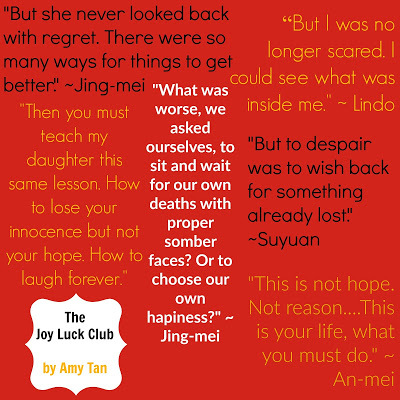 This does not happen very often, but, when it does, I always start researching the author. “How?” I ask myself. “How did she know?”
This does not happen very often, but, when it does, I always start researching the author. “How?” I ask myself. “How did she know?” Well, as it turns out, Amy Tan knows because she has Lyme disease. Like myself, she went undiagnosed for several years. No treatment has worked for her, but she keeps fighting. She has started an organization to help children with Lyme gain access to treatment. And she writes. She writes stories that she knows: Stories of pain and hope, tears and perseverance, real stories with real thoughts and real meanings.
That takes a lot of courage. Not many authors have that kind of courage, but Amy Tan is one of the beautiful few who still does.
One of the things that really stuck out to me was her handling of mother-daughter relationships. China’s culture is very different from America’s, so the relationship between the Chinese mothers and their Americanized daughters was difficult to read. There was a lot of friction, a lot of pain and misunderstandings, made all the worse because the mothers and daughters cared about each other but didn’t know how to show it.
An interesting part of the book was that the mothers were almost constantly cooking. That was how they showed their love. They could not speak it, but they could show it by spending hours preparing a meal for their family.
Because of this, The Joy Luck Club will do two things to you: It will make you sad but hopeful and it will make you hungry.
 Almost every chapter of this book made me want to go and try making some of the Chinese dishes described in it. The one that sounded the most interesting to me was the cilantro wonton soup. Since my Mom’s side of the family is Mexican, I’ve always viewed cilantro as something that belong exclusively to Mexican cooking. Stupid, I know, but I thought it highly entertaining to find cilantro in a Chinese meal.
Almost every chapter of this book made me want to go and try making some of the Chinese dishes described in it. The one that sounded the most interesting to me was the cilantro wonton soup. Since my Mom’s side of the family is Mexican, I’ve always viewed cilantro as something that belong exclusively to Mexican cooking. Stupid, I know, but I thought it highly entertaining to find cilantro in a Chinese meal.I decided to give it a try and, as it turns out, cilantro goes along awesomely in Chinese cuisine. The following recipe is vegetarian, dairy free, sugar free, and almost gluten free. I wasn’t able to find gluten-free wonton wrappers, so that part has wheat in it. Oh well. Anyway, here it is:
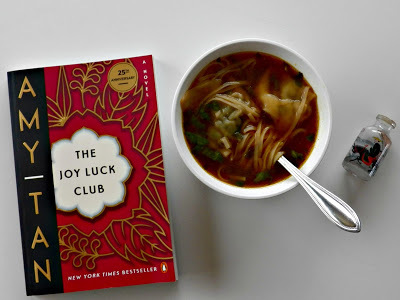 Ingredients - For Broth:8 cups of vegetable broth. Or chicken stock, if you don't want to go vegetarian. 3 green onions, chopped.1/2 cup of tamari. Or soy sauce. I like tamari better. 2 tablespoons of sesame oil 2 tablespoons of rice vinegar 2 teaspoons of siracha. Or sambal oelek. I didn't know it's name, so I had to Google: "Asian chili sauce with green lid." It knew exactly what I was talking about. I love Google.1 teaspoon of minced ginger For wontons: Wonton wrappers. You'll need about 30. I found mine at Sprouts, but, as I said, they weren't gluten-free. Boo. 1/2 cup of cilantro leaves, finely chopped2 cups of steamed spinach2 cups of chopped napa cabbage. Boil in water for 2 minutes, then strain under cold water. 3 green onions, chopped1 tablespoon of rice vinegar 1 tablespoon of tamari1 clove of garlic, crushed1 to 2 teaspoons of siracha, depending on how spicy you like your foods. 1/4 teaspoon of ginger1 tablespoon of water mixed with 1 tablespoon of cornstarch Salt to taste1. Throw all broth ingredients in a large pot. Bring to a simmer. Taste and then decide whether it needs tweaking.
Ingredients - For Broth:8 cups of vegetable broth. Or chicken stock, if you don't want to go vegetarian. 3 green onions, chopped.1/2 cup of tamari. Or soy sauce. I like tamari better. 2 tablespoons of sesame oil 2 tablespoons of rice vinegar 2 teaspoons of siracha. Or sambal oelek. I didn't know it's name, so I had to Google: "Asian chili sauce with green lid." It knew exactly what I was talking about. I love Google.1 teaspoon of minced ginger For wontons: Wonton wrappers. You'll need about 30. I found mine at Sprouts, but, as I said, they weren't gluten-free. Boo. 1/2 cup of cilantro leaves, finely chopped2 cups of steamed spinach2 cups of chopped napa cabbage. Boil in water for 2 minutes, then strain under cold water. 3 green onions, chopped1 tablespoon of rice vinegar 1 tablespoon of tamari1 clove of garlic, crushed1 to 2 teaspoons of siracha, depending on how spicy you like your foods. 1/4 teaspoon of ginger1 tablespoon of water mixed with 1 tablespoon of cornstarch Salt to taste1. Throw all broth ingredients in a large pot. Bring to a simmer. Taste and then decide whether it needs tweaking. 2. In a medium bowl, mix together all ingredients for the wonton filling.
 Fill a small bowl with water and set next to the bowl of wonton filling.
Fill a small bowl with water and set next to the bowl of wonton filling. 3. Place a wonton wrapper in one hand. With your other hand, dip a finger into the small bowl of water and brush all four corners of the wonton wrapper. Place 1/2 a teaspoon of the vegetable filling into the wonton wrapper.
4. Now go and wrap the wonton whatever way seems best to you. I'm no Auntie An-Mei (who makes this soup in the book), so I decided to keep it simple. I folded the wonton in half, forming a triangle. Then I folded two of the three corners inward. They'll look sort of like opened envelopes. Some of them didn't seal properly, so I folded all three corners inward. That's why some of them look like demented Howlers:
 5. Bring the broth to a boil. Drop the wontons into the pot and allow to boil for about 5 minutes (or whatever the instructions say on the wonton packaging). You don't want to boil for too long or the wontons will fall apart.
5. Bring the broth to a boil. Drop the wontons into the pot and allow to boil for about 5 minutes (or whatever the instructions say on the wonton packaging). You don't want to boil for too long or the wontons will fall apart.
 6. Add some extra cilantro to the top of the soup and enjoy.
6. Add some extra cilantro to the top of the soup and enjoy.7. This is optional: If you want, you can add some rice noodles to the soup. It gives it more substances and extra texture. I chose to do this because I'm in love with rice noodles, but you have my permission to leave them out if you can't fully appreciate them.
Now, while I'd like to say that the mothers from The Joy Luck Club would be proud of this dish, I honestly can't. They made it very clear in the story that Americans don't know how to make Chinese food. They're also each convinced that they are the best cooks around. So I'm just going to be satisfied with the fact that I liked this soup.
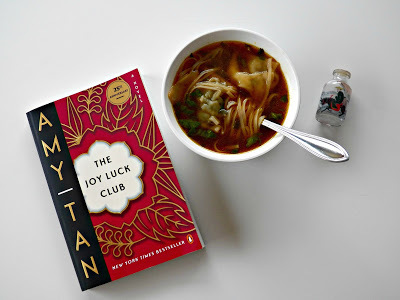 I can now add two new items to my list of things that make me happy: Amy Tan's writing and wonton soup.
I can now add two new items to my list of things that make me happy: Amy Tan's writing and wonton soup.While parts of The Joy Luck Club can be difficult because of the hard topics (forced marriages, abandoned children, broken relationships), I'm glad I read it. Why? Because it was difficult. Because it didn't shy away from the heavy topics or give easy answers. But it also didn't obscure all of the beautiful parts of life or forget to tell stories about hope and strength. In short: It told the truth. And I can't ask for more than that.
What about you? Have you read The Joy Luck Club ? What stood out to you the most? I'd love to hear your thoughts!
Related articles:
Orange Glazed Stir-Fry and Iced Citrus Green Tea Inspired by Randy Alcorn's Safely Home
Rosa Hubermann's Pea Soup Inspired by The Book Thief
Paleo Chocolate Pie Inspired by Kathryn Stockett's The Help
Enjoy this post? Take a look around. If you like what you see, please don't forget to subscribe by email for a new post every Friday!
Some links are Amazon affiliate links. Thank you for supporting a poor writer.

Published on January 29, 2016 07:59
January 22, 2016
The Rise of "Creeper Romance" in YA Fiction (And Why it Needs to Stop)
A list of things that people find romantic: chocolate and flowers. Red wine and moonlight. Walks on the beach and diamond rings. Someone saying “I love you” and actually meaning it. Dancing. Creepy stalker people.
Wait, what?
You heard me. Creepy stalker people.
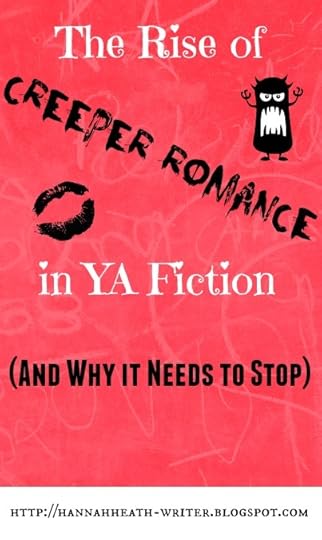 What is my basis for the statement? Only the fact that “creeper romance” has become exceedingly popular in fiction, particularly YA fiction. And everybody seems to be okay with that. In fact, guys with creeper tendencies are considered swoon-worthy by many readers.
What is my basis for the statement? Only the fact that “creeper romance” has become exceedingly popular in fiction, particularly YA fiction. And everybody seems to be okay with that. In fact, guys with creeper tendencies are considered swoon-worthy by many readers. I have proof. I also have several reasons as to why this is an extremely unhealthy trend. While I’d like to think that most people are intelligent enough to have discovered this for themselves, I’ve begun to notice that perhaps I give mankind too much credit. My bad.
Below are a list of characters with stalker/creeper tendencies, along with why they should not be praised as love interests. Please note that this post may rub you wrong, given that some of these characters have a large fanbase. So, before we get started, does anyone want to get out? No? Okay, you have been warned:
Edward Cullen. Stephanie Meyers’ gorgeous, sparkly vampire. I think we all know what I’m going to say about him, but, just in case you don’t, and because I never pass up a good chance to make fun of ridiculous characters, I will elaborate on why Edward Cullen is a creeper. But first, let me ask you a question: if you found out that somebody was following you around and watching you sleep, what would you do? If the same person was also always putting you down and making fun of you, sending dangerous glares in your direction, and then turning around and calling you their “own personal brand of heroin,” what would you do? My hope would be that you would call the police. I don’t care how good-looking the person is. I don’t care how strong or fast the person is. I don’t even care if the person happens to sparkle in the sunlight. Just because a person is gorgeous and in love with you doesn’t automatically make them romantic, harmless, or a good match.
 Source: Crazy Art Ideas
Source: Crazy Art IdeasUnfortunately, Bella Swan says otherwise. How on earth is that a good message to be sending? An adult wrote Twilight, and many adults praise it. And people turn around and wonder why so many teenagers are in unhealthy relationships. Yeah. I have no idea why teenagers are making bad dating calls. It’s like everything around them is telling them that it’s okay. Pfft. Absurd.
Evan Walker. For those of you who don’t know, this is the love interest from Ricky Yancey’s The 5th Wave . He’s perfect boyfriend material: he shoots her in the leg, sneaks around her camp while she’s asleep, tries to figure out whether or not he should kill her, reads her diary, stands around outside of her door, and is constantly lying to her. How adorable is that? It’s no wonder the main character falls for him. Sure, she had some misgivings over his creeperisms, but c’mon. His eyes are chocolate-colored, his hands are so soft, he’s saved her life, and he chose not to kill her when he was supposed to. That makes everything okay, right? Um, no. Here we see the idea that unrepentant stalkers should be given a chance if you find yourself a) thinking he’s handsome b) considering yourself indebted to him or c) flattered that he’s so into you. Flawless logic.
I know I'm about to bring a thousand screaming fangirls down on my head, but....Peeta Mellark. Yep. Peeta has a little bit of creeper in him. Remember that scene that everyone thought was so romantic? The one where he tells Katniss how he fell in love with her after hearing her sing at school? This is how it should’ve gone down:
Peeta: After that, I watched you going home every day. Every day. Well, say something.Katniss: Uh, Peeta? That’s weird. I’m pretty sure that watching somebody walk home every day is considered stalker. Also, we’re in life-threatening position. I’m scared. I’m worried about my family. I’d really appreciate it if you would just support me in my endeavors to survive, rather than constantly pushing yourself on me. You think you can do that?Peeta: Your hair was in two braids…Katniss: Okay, that’s it! I’m leaving.
Sorry, did I just step on Peeta’s moment? Yeah, probably. But seriously, there is nothing cute about a person constantly trying to get your attention even after you’ve said you aren’t interested. And there is absolutely nothing cute about a person showing a rude amount of interest in you.
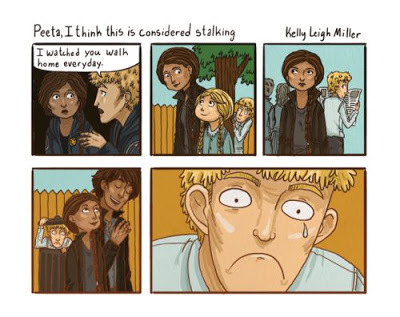 Barry Allen/The Flash. Not technically a book, but I think it’s interesting that this “creeper romance” trend spans all areas of entertainment, so I wanted to point it out here. Barry never tells his crush (Iris) that he likes her. She is not interested in him, and thus he is never able to get any kind of special attention from her. So of course he visits her multiple times as the mysterious Flash, who she becomes slightly infatuated with. Do I even have to comment on how weird that is? The same situation is repeated in Arrow between Oliver Queen and Laurel, though it's not quite as weird because Laurel has skills that Arrow needs to get certain jobs done. But still.
Barry Allen/The Flash. Not technically a book, but I think it’s interesting that this “creeper romance” trend spans all areas of entertainment, so I wanted to point it out here. Barry never tells his crush (Iris) that he likes her. She is not interested in him, and thus he is never able to get any kind of special attention from her. So of course he visits her multiple times as the mysterious Flash, who she becomes slightly infatuated with. Do I even have to comment on how weird that is? The same situation is repeated in Arrow between Oliver Queen and Laurel, though it's not quite as weird because Laurel has skills that Arrow needs to get certain jobs done. But still. Parzival from Ready Player One. In a virtual reality, Parzival follows a blog written by Art3mis. He develops a crush on this girl, spending hours reading her blog, trying to find ways to meet with her, and attempting to discover who she really is outside of the virtual reality. Of course he is rewarded for his tenacity by ending up in some semblance of a relationship with Art3mis. Because people who take their crushes to the extreme deserve to be rewarded. Obviously.
Ariel. The worst of them all. She secretly keeps a statue of her crush and then proceeds to infiltrate his home. Doesn't get much creepier than that.
 In case you're wondering whether I'm being serious or not, I'll tell you: I don't know. Sometimes I can't even tell whether I'm being sarcastic or not. But I am a fan of The Little Mermaid, so I guess I'm kidding. Maybe. Okay, moving on...
In case you're wondering whether I'm being serious or not, I'll tell you: I don't know. Sometimes I can't even tell whether I'm being sarcastic or not. But I am a fan of The Little Mermaid, so I guess I'm kidding. Maybe. Okay, moving on...Honorable Mentions. I asked my followers on Facebook to list some characters that fall into the "creeper romance" zone. They came up with a lot of great ones. You can check that out here.
What makes the "creeper romance" difficult is that sometimes it isn't extremely obvious. Sometimes the creepers aren't dangerous and are actually decent people (Peeta, Barry Allen....Ariel...?). But that should not make their behavior acceptable, nor should it keep the object of their affection from rebuking them. I'd love to see more girls (...and princes..?) in fiction who speak out against such actions instead of mindlessly accepting it as normal (and even desirable).
Have you noticed any "creeper romance" in any of your own writing? If so, I would urge you to consider rewriting. Why? Because it is very unhealthy to be sending a message that "creeperism" is okay, normal, and bound to turn out well. I've never heard of "creeper romance" working out in real life, so I can't imagine why we should be encouraging such behavior through the actions of our book characters.
What do you think? Agree or disagree? Feel free to point out any characters that I missed (Hint: there are dozens) and weigh in with your own analysis of the "rise of creeper romance."
Related articles:
Romance in YA Novels: The Good, The Bad, and The Stupid
Keeping it Classy: When is it OK to use Profanity in Your Fiction Writing?
Writing Awesome Male Characters: What You're Doing Wrong
Enjoy this post? Take a look around. If you like what you see, please don't forget to subscribe by email for a new post every week!

Published on January 22, 2016 06:54
January 15, 2016
8 Problems in the Christian Fiction Genre (And How to Fix Them)
I’ll admit it. I don’t enjoy reading modern Christian fiction. I know this statement isn’t very unique, because a lot of people don’t like that particular genre. But here’s the interesting part: I’m a Christian. A Christian who writes Christian fiction.
So if Hannah, a Christian author of Christian fiction, doesn’t like modern Christian fiction, then I’m pretty sure that’s a huge red flag. And the fact that I know a few other Christians who aren’t particularly thrilled with this genre is an even larger red flag.
What has happened to this genre that has caused the people most likely to enjoy it to turn away?
Well, I have some ideas about that. Here are a few common problems within modern Christian fiction books, along with ways to fix them:
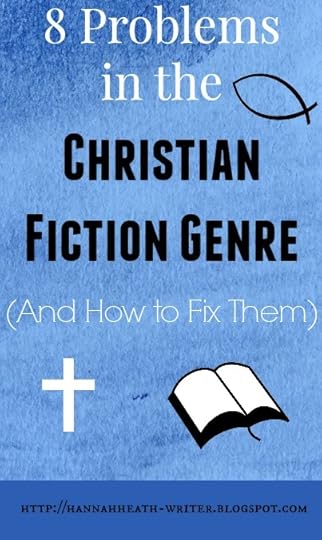 They’re formulaic.Has anyone ever noticed that most modern Christian fiction follows the same general storyline? The character who is kind of (but not really) on the fence about Christianity. The conflict involves being confused or angry (but not tooconfused or angry, because that’s blasphemous) with God when bad things happen. If it’s fiction, the conflict is resolved by the MC realizing that God was right all along (surprise!). If it’s fantasy, the conflict is resolved after a long inner-struggle and the killing of a demonic force. Rather than copying this stereotypical plot, how about we write something of our own? A wild idea, I know, but I’m sure we can make it work. They tend to contain the same antagonist. The bad guy is almost always either atheist or a demon. The atheist hates believers, usually because something bad happened to him that caused him to turn from the faith. The demon hates believers because...er...that’s kind of his job. There’s nothing wrong with demonic bad guys, but c’mon. We can do better than suave dudes in suits or sexy, red-lipped ladies. Also, please note that being non-Christian does not make a person evil. Christians are just as messed up as non-Christians, so try not to take a narrow view of things. Wouldn’t it be interesting to have an antagonist who thinks he’s Christian, but has a very different and warped view of what a “Christian” is? There are so many different ways to write villains, so let's look beyond just two types. There aren’t very many subgenres. It seems like most Christian fiction is either some kind of fictional romance novel, a good vs. evil fantasy, a story about a missionary, or an end-time story that’s a rip-off of Revelation. That’s about it. But nobody said that we have to confine ourselves to these genres. So please, for the love of Christian writing, think outside of the box! There’s no reason that Christian fiction can’t span pretty much all genres.The answers come too easily. In other words, Christian fiction portrays the world in a much too fluffy manner. The character struggles with coming to terms with his faith, but then the scales fall from his eyes and everything is okay. Not only does this not make for a good storyline, but it’s simply not true. Gaining faith is not easy. Keeping it is pretty hard, too. If a book is to send a meaningful message, then it must be truthful. Don't sugar-coat. Life can be dark and ugly. Believing in Jesus doesn't automatically make that go away. So tell the truth. Despite what some movie characters say, we can handle it.Christian fiction skirts around difficult issues. I think a lot of Christian writers have the idea that they aren’t allowed to bring up serious questions against God’s existence, his love, or his reasons for allowing suffering. This is a misguided idea. I think C.S. Lewis explained this best in The Weight of Glory: “If our religion is something objective, then we must never avert our eyes from those elements in it which seem puzzling or repellent; for it will be precisely the puzzling or the repellent which conceals what we do not yet know and need to know.” There is nothing wrong with questioning and exploring Christianity and God in your writing. In fact, this questioning tends to be what will allow your book to help others....And yourself. Is this scary? Yes. But if it’s not scary, chances are it’s not worth writing about.It targets only Christian readers. Christian fiction should not be something only enjoyable to Christians. How are we supposed to reach people if we stay in our own little bubble? The fact that a Christian novel is only liked by Christians means that it’s doing something terribly wrong: It’s relying on a common link between the writer and the reader (Christianity) to cover up all of the plot holes, preachy scenes, and fluff. This is not okay. If you cannot send a message about Jesus in a way that is understandable and relatable to those who don’t believe in him, then you probably shouldn’t be attempting to write Christian fiction. Harsh but true. Everyone’s trying to be C.S. Lewis. And this is in no way conducive to creating unique, helpful novels. Remember: You are you. You are a good writer. Go write like no one else can. Go write like yourself.It’s too preachy. Unless you’re a dictator, books should not be used as brain-washing propaganda. I’ve said it before in relation to other writing, and I’ll say it again in relation to Christian fiction: If you feel the need to preach, then you’re coming at this in entirely the wrong way. If you cannot get your message across through characters, actions, and symbolism in a strong yet pleasant way, then you’re doing it wrong. Write a story, not a sermon. Sermons cannot be stories. But sometimes stories can be the very best kind of sermon: a beautiful, helpful, penetrating message that will be remembered long after the book is closed.I think the biggest problem with Christian writing comes from the fact that authors are human, and thus struggle with how to come to terms with, and write about, the problems of the world in light of their faith. This generally leads to books that are either too aggressively protective of their faith (leading to Bible thumping), or too insecure in it (leading to timid, fluffy writing).
They’re formulaic.Has anyone ever noticed that most modern Christian fiction follows the same general storyline? The character who is kind of (but not really) on the fence about Christianity. The conflict involves being confused or angry (but not tooconfused or angry, because that’s blasphemous) with God when bad things happen. If it’s fiction, the conflict is resolved by the MC realizing that God was right all along (surprise!). If it’s fantasy, the conflict is resolved after a long inner-struggle and the killing of a demonic force. Rather than copying this stereotypical plot, how about we write something of our own? A wild idea, I know, but I’m sure we can make it work. They tend to contain the same antagonist. The bad guy is almost always either atheist or a demon. The atheist hates believers, usually because something bad happened to him that caused him to turn from the faith. The demon hates believers because...er...that’s kind of his job. There’s nothing wrong with demonic bad guys, but c’mon. We can do better than suave dudes in suits or sexy, red-lipped ladies. Also, please note that being non-Christian does not make a person evil. Christians are just as messed up as non-Christians, so try not to take a narrow view of things. Wouldn’t it be interesting to have an antagonist who thinks he’s Christian, but has a very different and warped view of what a “Christian” is? There are so many different ways to write villains, so let's look beyond just two types. There aren’t very many subgenres. It seems like most Christian fiction is either some kind of fictional romance novel, a good vs. evil fantasy, a story about a missionary, or an end-time story that’s a rip-off of Revelation. That’s about it. But nobody said that we have to confine ourselves to these genres. So please, for the love of Christian writing, think outside of the box! There’s no reason that Christian fiction can’t span pretty much all genres.The answers come too easily. In other words, Christian fiction portrays the world in a much too fluffy manner. The character struggles with coming to terms with his faith, but then the scales fall from his eyes and everything is okay. Not only does this not make for a good storyline, but it’s simply not true. Gaining faith is not easy. Keeping it is pretty hard, too. If a book is to send a meaningful message, then it must be truthful. Don't sugar-coat. Life can be dark and ugly. Believing in Jesus doesn't automatically make that go away. So tell the truth. Despite what some movie characters say, we can handle it.Christian fiction skirts around difficult issues. I think a lot of Christian writers have the idea that they aren’t allowed to bring up serious questions against God’s existence, his love, or his reasons for allowing suffering. This is a misguided idea. I think C.S. Lewis explained this best in The Weight of Glory: “If our religion is something objective, then we must never avert our eyes from those elements in it which seem puzzling or repellent; for it will be precisely the puzzling or the repellent which conceals what we do not yet know and need to know.” There is nothing wrong with questioning and exploring Christianity and God in your writing. In fact, this questioning tends to be what will allow your book to help others....And yourself. Is this scary? Yes. But if it’s not scary, chances are it’s not worth writing about.It targets only Christian readers. Christian fiction should not be something only enjoyable to Christians. How are we supposed to reach people if we stay in our own little bubble? The fact that a Christian novel is only liked by Christians means that it’s doing something terribly wrong: It’s relying on a common link between the writer and the reader (Christianity) to cover up all of the plot holes, preachy scenes, and fluff. This is not okay. If you cannot send a message about Jesus in a way that is understandable and relatable to those who don’t believe in him, then you probably shouldn’t be attempting to write Christian fiction. Harsh but true. Everyone’s trying to be C.S. Lewis. And this is in no way conducive to creating unique, helpful novels. Remember: You are you. You are a good writer. Go write like no one else can. Go write like yourself.It’s too preachy. Unless you’re a dictator, books should not be used as brain-washing propaganda. I’ve said it before in relation to other writing, and I’ll say it again in relation to Christian fiction: If you feel the need to preach, then you’re coming at this in entirely the wrong way. If you cannot get your message across through characters, actions, and symbolism in a strong yet pleasant way, then you’re doing it wrong. Write a story, not a sermon. Sermons cannot be stories. But sometimes stories can be the very best kind of sermon: a beautiful, helpful, penetrating message that will be remembered long after the book is closed.I think the biggest problem with Christian writing comes from the fact that authors are human, and thus struggle with how to come to terms with, and write about, the problems of the world in light of their faith. This generally leads to books that are either too aggressively protective of their faith (leading to Bible thumping), or too insecure in it (leading to timid, fluffy writing). If you fall into the first group: try to keep an open mind in your writing and understand that you cannot make everyone believe what you do.
And if you fall into the second group: it’s okay. Nobody expects you to have all of the answers. They just expect you to be truthful enough to admit that you have questions.
But, no matter what group you’re in, remember to pray. You can’t write something meaningful without guidance.
What do you think? Whether you’re a Christian writer or otherwise, please jump in with your thoughts. What areas would you like to see improvement in when it comes to Christian novels? What Christian books have you read that you thought were done well? Please keep comments thoughtful and respectful.
Related articles:
Challenging Writers to Create Stories With Meaning
8 Stereotypes in YA Dystopian Novels
7 Cliche Characters in YA Fiction That Need to Stop
Enjoy this post? Take a look around. If you like what you see, please don't forget to subscribe by email for a new post every week!

Published on January 15, 2016 08:39
January 11, 2016
In Which I Participate in the Infinity Dreams Award and The Sunshine Blogger Award
In case you haven't noticed yet, Random and I are very good friends and always have a lot of fun together.
Because of this, you can imagine my excitement when the ever-awesome Nate Philbrick nominated me for the Infinity Dreams Award, an event quickly followed by Gabrielle Massman kindly tagging me to participate in the Sunshine Blogger Award. Both of these awards include answering random questions or giving out random facts. Randomness, here I come! But first, a little introduction:
 Inf...
Inf...
Because of this, you can imagine my excitement when the ever-awesome Nate Philbrick nominated me for the Infinity Dreams Award, an event quickly followed by Gabrielle Massman kindly tagging me to participate in the Sunshine Blogger Award. Both of these awards include answering random questions or giving out random facts. Randomness, here I come! But first, a little introduction:
 Inf...
Inf...
Published on January 11, 2016 12:56
January 8, 2016
9 Ways to Use Reading to Improve Your Writing
We are a rare breed. We spend hours by ourselves. We visit new worlds and times on a regular basis. Our favorite people constantly die before our eyes. We are collectors and protectors of both the history and the future.
Who are we?
No, not Time Lords. Bookworms!
If you’re reading this blog, chances are you have an affinity for reading. Most writer’s do. I touched briefly on the idea of how reading can help writing in my newsletter, but I’d like to expand on that a bit more today.
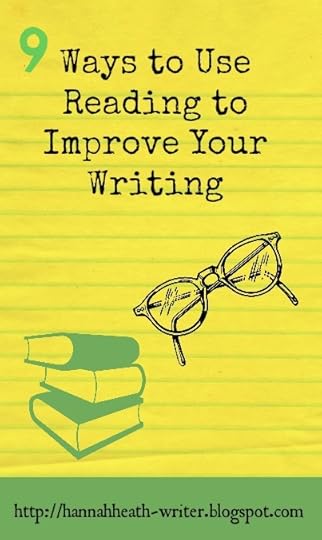 It’s odd to think that we learn to write by reading books that were written by other people, people who honed their talent by reading another’s work. Writing is an endless loop of ideas, writing styles, and people’s lives. It’s quite beautiful, if you ever stop to think about it.
It’s odd to think that we learn to write by reading books that were written by other people, people who honed their talent by reading another’s work. Writing is an endless loop of ideas, writing styles, and people’s lives. It’s quite beautiful, if you ever stop to think about it. Anyway, here are 9 ways you can use reading to improve your writing: Use books as tools to write. It’s a writer’s job to describe places we’ve never been, write about people we aren’t, and expose points of view that people have long forgotten. How are we supposed to do this well? Through reading. Reading not only feeds us new ideas, but it explains to us people and places that we would have never been able to understand. Bookshelves are like a writer’s toolbox. Dig around enough and you’ll find a way to approach that one character, write about that certain topic, or fill up that plot hole. No, this isn’t steal, something that I’ve explained here.Don’t just read in the genre that you write. This is a brilliant way to turn out cliché, shallow stories. While there’s nothing wrong with reading in your genre, there is something wrong with reading exclusively in that genre. If you’re going to read, then read. Read classics, historical fiction, nonfiction, fantasy, sci-fi, graphic novels, manga. By doing this, you will be broadening your scope, allowing yourself to write in ways different than many authors in your genre. Besides, most genres have the same themes and ideas, just expressed in a different way. Sometimes seeing this new way will give you the kick you need in your own writing.Read thoughtfully. Study the story. Delve into the characters. Don’t just read a book and think, “That was good” or “That was bad.” Do NOT like or dislike a book simply because everyone else does. Identify the specific parts that made the story good or bad. Ask yourself how you would have done it differently. Learn from other authors. Books are more than entertainment, so treat them as such. Learn from them. Not only will this better your writing, but it will sharpen your intellect and feed your soul.Read thoughtlessly. I know, I know. I just said to read thoughtfully. However, sometimes it’s helpful to simply read a book for the enjoyment of it. Don’t ask yourself why it makes you feel the way you do. Don’t try to understand it. Just read. Then, when you are done, go back and think very hard about the book. Search for problems, plot holes, the good parts, the bad parts. Notice how your perception of the book changes. Notice what parts of books often seem good, but end up being shallow upon close scrutiny. This will help you from writing a story that contains mostly fluff and nonsense.Read brilliant books. Go out of your way to read books that you know to be brilliant. While it’s never a good idea to compare yourself to another writer, it’s always helpful to have writers to look up to and learn from.Read lame books. If a book is badly done, don’t just throw it out. Sometimes bad books can be helpful. Not only does it show you how not to write (which is sometimes more helpful than learning how to write), but it can give you some hope. I mean, if junk like that can get published, you should be able to publish your own stuff, right? Also, you can look at those bad books and be determined to keep any of your novels from ever being that bad. So really, bad books aren’t worthless. There is grace in their failings. That being said, I wouldn’t suggest going out of your way to ready sucky books.Open your mind. Open your mind to what exactly it is that makes a good story. Be ready to encounter new and strange writing techniques. Ask questions. Challenge yourself and your ideas. There are so many books, blog posts, and people telling you about what makes up good writing. Try to forget them all and make up your own mind based on the books that you read.Question everything. This is closely connected to reading thoughtfully, but I thought it should get it's own paragraph because it's so darn important. Questioning plot points and character motivation in other people's books will lead your to do the same for your own writing. In fact, it's probably best to read books like Gwen:
 As long as you can do this without being rude and cynical, that is. I'm halfway there. Just gotta get rid of the cynical side. But, let's be honest. The odds of that are about 3,720 to 1.Read books that mean something to you. At the end of the day, a book is only as good, as truthful, and as wise as its author. If you want to write a book with meaning, then you’re going to have to find a way to make your own life meaningful. Do you have questions about the problem of pain? Read books about it. Fighting against depression, chronic pain, marital problems? Read. And, of course, find somebody you can talk to about the world and the questions you have. This is key. The better you can express yourself and identify your own questions, the better equipped you will be to write character and their problems.It’s also interesting to note that these ideas also apply to movies and music. After all, films and melodies are a style of storytelling, too. I think often times we forget the value of a story. We forget that, though they can entertain, they can also teach, create, destroy, and improve. Books really are magnificent, and it's important to remember just how magnificent they are so that we can use them correctly.
As long as you can do this without being rude and cynical, that is. I'm halfway there. Just gotta get rid of the cynical side. But, let's be honest. The odds of that are about 3,720 to 1.Read books that mean something to you. At the end of the day, a book is only as good, as truthful, and as wise as its author. If you want to write a book with meaning, then you’re going to have to find a way to make your own life meaningful. Do you have questions about the problem of pain? Read books about it. Fighting against depression, chronic pain, marital problems? Read. And, of course, find somebody you can talk to about the world and the questions you have. This is key. The better you can express yourself and identify your own questions, the better equipped you will be to write character and their problems.It’s also interesting to note that these ideas also apply to movies and music. After all, films and melodies are a style of storytelling, too. I think often times we forget the value of a story. We forget that, though they can entertain, they can also teach, create, destroy, and improve. Books really are magnificent, and it's important to remember just how magnificent they are so that we can use them correctly. What about you? Do you use reading to better your writing skills, or have you simply never thought of it? Did I miss any points? Please leave a comment below!
Related articles:
Challenging Writers to Create Stories With Meaning
6 Reasons You Should Be Writing Short Stories....And 5 Tips to Help You Get Started
6 Easy Ways to Gain Writing Inspiration
Enjoy this post? Take a look around. If you like what you see, please don't forget to subscribe by email for a new post every week!

Published on January 08, 2016 11:15



